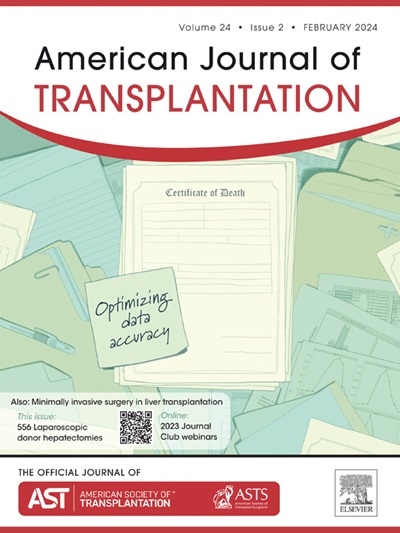腺相关病毒介导的PD-L1在啮齿动物肺移植模型中的转导
IF 8.2
2区 医学
Q1 SURGERY
引用次数: 0
摘要
急性细胞排斥反应(ACR)是移植后慢性同种异体肺功能障碍(CLAD)的关键因素;虽然可以治疗,但传统的免疫抑制(IS)疗法与显著的副作用相关。基因治疗提供了一种方法来调节受体免疫反应,同时尽量减少传统IS的毒性。在这项研究中,我们评估了aav介导的PD-L1过表达,这是一种T细胞的抑制配体,在大鼠单肺移植模型中。将同种异体褐挪威肺移植到Fischer F344受体中,并分为三组:(1)经支气管静冷藏的AAV9-PD-L1,(2)无病毒对照,或(3)aav9 -荧光素酶对照。所有动物术后第1天注射CTLA-4免疫球蛋白,第14天处死。排斥反应由盲肺移植病理学家评估,PD-L1表达和CD8+ t细胞浸润通过免疫组织化学评估。通过POD14, AAV9-PD-L1组的排斥反应严重程度(平均评分1.40)明显低于对照组(平均评分3.60;p = 0.005)。aav9 -荧光素酶组表现出与无病毒对照组相当的排斥评分(平均3.5)。免疫组织化学证实了外源性PD-L1的表达,但CD8+ t细胞计数在两组间无显著差异。这些发现表明,AAV PD-L1基因递送可以减轻肺移植的ACR,为改善预后提供了一种潜在的策略。本文章由计算机程序翻译,如有差异,请以英文原文为准。
Adeno-associated virus–mediated transduction of PD-L1 in a rodent lung transplant model
Acute cellular rejection is a key contributor to chronic lung allograft dysfunction following transplantation; while treatable, traditional immunosuppressive therapies are associated with significant side effects. Gene therapy offers an approach to modulate recipient immune responses while minimizing the toxicity of conventional immunosuppressive therapy. In this study, we evaluated adenoassociated virus (AAV)-mediated programmed death-ligand (PD-L)1 overexpression, an inhibitory ligand of T cells, in a rat single-lung transplant model. Allogeneic Brown Norway lungs were transplanted into Fischer F344 recipients and assigned to 3 groups: (1) AAV9–PD-L1 via the bronchus during static cold storage, (2) no-virus control, or (3) AAV9-luciferase control. All animals received cytotoxic T lymphocyte–associated protein 4 immunoglobulin on postoperative day (POD)1, and killed on POD14. Rejection was evaluated by a blinded lung transplant pathologist, and PD-L1 expression and CD8+ T cell infiltration assessed via immunohistochemistry. By POD14, the AAV9–PD-L1 group displayed significantly reduced rejection severity (mean score 1.40) compared to controls (mean 3.60; p=0.005). The AAV9-luciferase group exhibited comparable rejection scores to no-virus controls (mean 3.5). Immunohistochemistry confirmed exogenous PD-L1 expression, however no significant difference in CD8+ T cell count was observed between groups. These findings demonstrate that AAV–PD-L1 gene delivery can attenuate acute cellular rejection in lung transplants, offering a potential strategy to improve outcomes.
求助全文
通过发布文献求助,成功后即可免费获取论文全文。
去求助
来源期刊
CiteScore
18.70
自引率
4.50%
发文量
346
审稿时长
26 days
期刊介绍:
The American Journal of Transplantation is a leading journal in the field of transplantation. It serves as a forum for debate and reassessment, an agent of change, and a major platform for promoting understanding, improving results, and advancing science. Published monthly, it provides an essential resource for researchers and clinicians worldwide.
The journal publishes original articles, case reports, invited reviews, letters to the editor, critical reviews, news features, consensus documents, and guidelines over 12 issues a year. It covers all major subject areas in transplantation, including thoracic (heart, lung), abdominal (kidney, liver, pancreas, islets), tissue and stem cell transplantation, organ and tissue donation and preservation, tissue injury, repair, inflammation, and aging, histocompatibility, drugs and pharmacology, graft survival, and prevention of graft dysfunction and failure. It also explores ethical and social issues in the field.

 求助内容:
求助内容: 应助结果提醒方式:
应助结果提醒方式:


